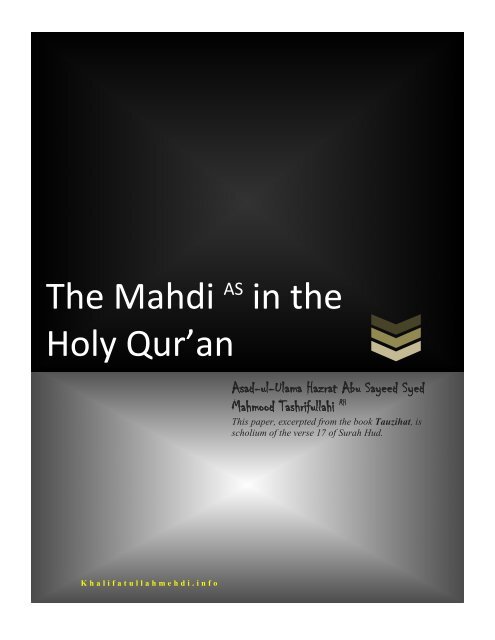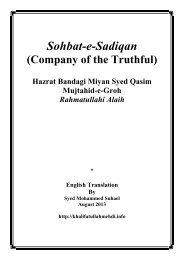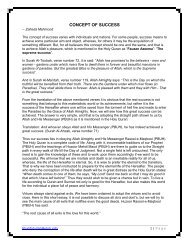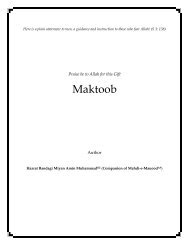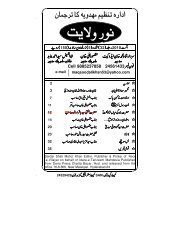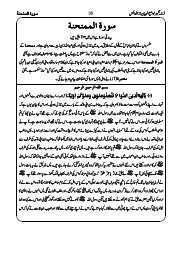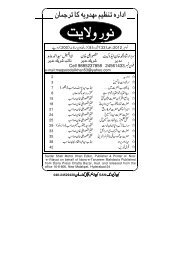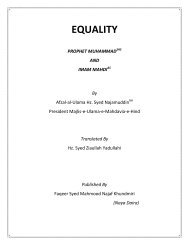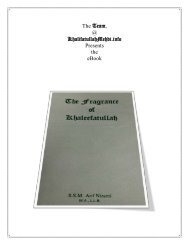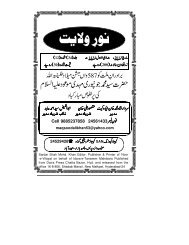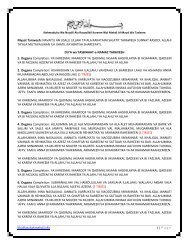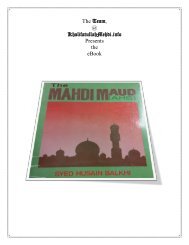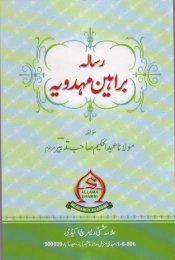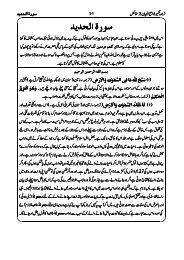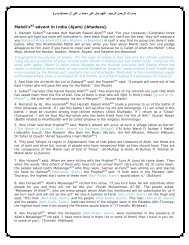The Mahdi AS in the Holy Qur'an - Khalifatullah Mehdi
The Mahdi AS in the Holy Qur'an - Khalifatullah Mehdi
The Mahdi AS in the Holy Qur'an - Khalifatullah Mehdi
Create successful ePaper yourself
Turn your PDF publications into a flip-book with our unique Google optimized e-Paper software.
<strong>The</strong> <strong>Mahdi</strong> <strong>AS</strong> <strong>in</strong> <strong>the</strong><strong>Holy</strong> Qur’anAsad-ul-Ulama Hazrat Abu Sayeed SyedMahmood Tashrifullahi RHThis paper, excerpted from <strong>the</strong> book Tauzihat, isscholium of <strong>the</strong> verse 17 of Surah Hud.<strong>Khalifatullah</strong>mehdi.<strong>in</strong>fo
Excerpt from TauzihatAsad-ul-Ulama Hzt Abu Sayeed RH<strong>The</strong> <strong>Mahdi</strong> <strong>AS</strong> <strong>in</strong> <strong>the</strong> <strong>Holy</strong> Qur’anImam <strong>Mahdi</strong> <strong>AS</strong> has recited this Quranic Verse <strong>in</strong> proof of his <strong>Mahdi</strong>at (<strong>Mahdi</strong>-ship): Allahsays, “Is he (to be counted equal to <strong>the</strong>m) who relieth on a clear proof from his Lord, and awitness from Him reciteth it, and before it was <strong>the</strong> Book of Moses, an example and amercy? Such believe <strong>the</strong>re<strong>in</strong>, and whoso disbelieveth <strong>the</strong>re<strong>in</strong> of <strong>the</strong> clans, <strong>the</strong> Fire is hisappo<strong>in</strong>ted place. So be not thou <strong>in</strong> doubt concern<strong>in</strong>g it. Lo! It is <strong>the</strong> Truth from thy Lord;but most of mank<strong>in</strong>d believe not.” 1 <strong>The</strong> Imam <strong>AS</strong> said <strong>in</strong> tafsir (elucidation) of <strong>the</strong> Verse, “Iam listen<strong>in</strong>g directly from Allah Most High that this Verse is <strong>in</strong> my favour. ‘<strong>The</strong> man <strong>in</strong>Afaman-kaana means you. And Bayyi-na means <strong>the</strong> emulation, <strong>in</strong> word, deed andcondition, of <strong>the</strong> vilayat (sa<strong>in</strong>thood) of Hazrat Muhammad Mustafa SLM , which isparticularly associated with his zath (nature, essence). Shaa-hidum means Quran andTorah. Ulaaa-‘ika refers to <strong>the</strong> emulat<strong>in</strong>g groups (ummah) of followers. Bihii <strong>in</strong> both placesmeans <strong>the</strong> Imam <strong>AS</strong> .’”<strong>The</strong> Traditions of Prophet SLM that conform with <strong>the</strong> Quran are of a very high grade. As such itdeserves great attention that <strong>the</strong> number of traditions about <strong>the</strong> advent of Imam <strong>Mahdi</strong> <strong>AS</strong> is verylarge. <strong>The</strong>re is some controversy, however, about his signs and <strong>the</strong> place of his birth. But <strong>the</strong>re isunanimity about his advent. Hence, <strong>the</strong> scholars of <strong>the</strong> yore have made it a part of <strong>the</strong> beliefs(a’tiqadiat) and <strong>the</strong>y have accepted <strong>the</strong> constancy and frequency (tawatur) of <strong>the</strong> mean<strong>in</strong>g of <strong>the</strong>seTraditions. How can such a glorious precept be<strong>in</strong>g omitted <strong>in</strong> Quran be true or correct, when Allahhas said about <strong>the</strong> Quran, “…<strong>The</strong>re is not a gra<strong>in</strong> <strong>in</strong> <strong>the</strong> darkness (or depths) of <strong>the</strong> earth, noranyth<strong>in</strong>g fresh or dry (green or wi<strong>the</strong>red) but is (<strong>in</strong>scribed) <strong>in</strong> a Record clear (to those who canread). 2 A large number of scholars did not focus <strong>the</strong>ir attention on conform<strong>in</strong>g <strong>the</strong>se Traditions to<strong>the</strong> Quran. One of <strong>the</strong> reasons for this lapse could be that <strong>the</strong>y thought <strong>the</strong> constancy of mean<strong>in</strong>g <strong>in</strong><strong>the</strong> Traditions about <strong>the</strong> Imam <strong>Mahdi</strong> <strong>AS</strong> was enough, and, <strong>in</strong> fact, that was enough. Hafiz Ibn Hajar‘Asqalani has said, “In <strong>the</strong> Traditions of constancy, <strong>the</strong> rijal 3 are not discussed, because <strong>the</strong>y (<strong>the</strong>Traditions) are reliable and certa<strong>in</strong>, even if <strong>the</strong>y are reported or narrated by s<strong>in</strong>ners or <strong>in</strong>fidels(kafirs).”Despite this, conform<strong>in</strong>g <strong>the</strong>se Traditions to <strong>the</strong> Quran makes it easy to f<strong>in</strong>d out which of <strong>the</strong>Quranic Verses <strong>the</strong>y expla<strong>in</strong> (tafsir). But <strong>in</strong> <strong>the</strong> books written by those commentators andresearchers who have focused <strong>the</strong>ir attention on this po<strong>in</strong>t, we f<strong>in</strong>d <strong>the</strong> mention of Imam <strong>Mahdi</strong> <strong>AS</strong> <strong>in</strong><strong>the</strong>ir expositions of certa<strong>in</strong> Quranic Verses. In fact, accord<strong>in</strong>g to <strong>the</strong> Quranic Verse, “<strong>The</strong>reafter <strong>the</strong>responsibility is Ours to let its mean<strong>in</strong>g be clear (to everyone), 4 <strong>the</strong> discharg<strong>in</strong>g of this responsibilitywas dest<strong>in</strong>ed for <strong>the</strong> Imam <strong>AS</strong> . Hence, <strong>the</strong> <strong>in</strong>telligence of many of <strong>the</strong> scholars was deficient. Happily,Allah imparted <strong>the</strong> knowledge about <strong>the</strong>se Quranic Verses, <strong>in</strong> which <strong>the</strong>re are <strong>in</strong>dications about <strong>the</strong>1 Quran, S. 11: 17 [Mohammed Marmaduke Pickthal - MMP] -Afaman-kaana ‘alaa Bayyi-na-tim-mir-Rabbi-hii wa yatluuhuShaa-hidum-m<strong>in</strong>-hu wa m<strong>in</strong>-qab-lihii Kitaabu Muusaa’ imaa-manwwa rah-mah! ‘Ulaaa-‘ika yu’mi-nuuna bih.Wa manyyak-fur bihii m<strong>in</strong>al-‘Ah-zaabi fannaaru maw-‘idhu. Falaa taku fii mir-ya-tim-m<strong>in</strong>h: ‘<strong>in</strong>nahul-Haqqu mir-Rabbika wa laak<strong>in</strong>na ‘ak-saran-naasi laa yum<strong>in</strong>uun!2 Quran, S. 6: 59 [Abdullah Yusuf Ali - AYA].3 Rijal means those persons who have reported or narrated <strong>the</strong> Traditions.4 Quran, S. 75: 19 [Syed Abdul Latif - SAL].<strong>Khalifatullah</strong>mehdi.<strong>in</strong>fo1 | Page
Excerpt from TauzihatAsad-ul-Ulama Hzt Abu Sayeed RHImam <strong>AS</strong> , through Imam Syed Muhammad <strong>AS</strong> of Jaunpur himself. We have already discussed why <strong>the</strong>word, <strong>Mahdi</strong>, does not occur 5 <strong>in</strong> Quran. In short, one of <strong>the</strong> Quranic Verses, <strong>in</strong> which <strong>the</strong>re is an<strong>in</strong>dication about Imam <strong>Mahdi</strong> <strong>AS</strong> , is expla<strong>in</strong>ed <strong>in</strong> Parable 3. Imam <strong>Mahdi</strong> <strong>AS</strong> offered this Quranic Verse 6<strong>in</strong> proof of his be<strong>in</strong>g Imam <strong>Mahdi</strong> <strong>AS</strong> , by <strong>the</strong> command of Allah, and said: “I am listen<strong>in</strong>g directlyfrom Allah Most High that this Verse <strong>in</strong> my favour. (Allah says) ‘<strong>The</strong> man <strong>in</strong> Afaman kaana meansyou. And Bayyi-na means <strong>the</strong> follow<strong>in</strong>g, <strong>in</strong> word, deed and condition (hal) of <strong>the</strong> vilayat (sa<strong>in</strong>thood)of Prophet Muhammad Mustafa SLM , which is particularly associated with his zath (nature, essence).Shaa-hidum means Quran and Torah. Ulaaa-‘ika refers to <strong>the</strong> emulat<strong>in</strong>g groups (ummah) offollowers. Bihii <strong>in</strong> both places means <strong>the</strong> Imam <strong>AS</strong> .’”<strong>The</strong> details of this abstract are that <strong>the</strong> word, man, <strong>in</strong> Afaman kaana, refers to one person,<strong>Mahdi</strong> al-Mau’ood Khalifathullah <strong>AS</strong> . <strong>The</strong> follow<strong>in</strong>g are <strong>the</strong> arguments to prove it: (1) <strong>The</strong> pronounsused <strong>in</strong> relation to this Arabic word, man, are s<strong>in</strong>gular, like mir-Rabbi-hii, yat-luuhu, m<strong>in</strong>hu etc. But<strong>in</strong> a previous Verse <strong>in</strong> Quran, Man-kaana yurii-dul-Hayaatad-Dunya…(to <strong>the</strong> end of <strong>the</strong> text), 7 <strong>the</strong>word, man, is general and <strong>the</strong> pronouns used <strong>in</strong> relation to it are all <strong>in</strong> plural, like nu-waffi ‘ilay-him‘a‘-maala-hum, laa-yub-kha-suun etc. (2) Man has to be Sahib-e-Bayy<strong>in</strong>a and this attribute isparticular to a Vice-Regent of Allah. If one were to take man to mean common believers, it wouldbecome necessary to allow all <strong>the</strong> believers to have <strong>the</strong> attributes of Prophet-hood and <strong>the</strong> viceregencyof Allah <strong>in</strong> <strong>the</strong>m. It is for this reason that <strong>the</strong> ayaat and bayy<strong>in</strong>at (verses and clear proof)have been used <strong>in</strong> Quran only <strong>in</strong> respect of issues, which are beyond <strong>the</strong> pale of human power,whe<strong>the</strong>r <strong>the</strong>y are related to <strong>the</strong> issues of <strong>the</strong> Prophets or <strong>the</strong>y are an argument <strong>in</strong> favour of <strong>the</strong>irProphet-hood, or <strong>the</strong>y are a proof of <strong>the</strong> special Div<strong>in</strong>e Power (qudrat-e-Ilahia). <strong>The</strong> ayaat andbayy<strong>in</strong>at have also been applied to both of <strong>the</strong>se, because <strong>in</strong> both situations <strong>the</strong> application of <strong>the</strong>ayaat and bayy<strong>in</strong>at is related to <strong>the</strong> Div<strong>in</strong>e Power. It is for this reason that <strong>the</strong> disavowal of <strong>the</strong> ayaatand bayy<strong>in</strong>at necessitates <strong>the</strong> disavowal of <strong>the</strong> Div<strong>in</strong>e Power. Allah has said, “None but disbelieversdeny <strong>the</strong> Revelations of Allah: let not <strong>the</strong>ir outward prosperity <strong>in</strong> <strong>the</strong> land deceive <strong>the</strong>e.” 8 However,it appears at <strong>the</strong> first glance that <strong>the</strong> word bayy<strong>in</strong>a has been used for <strong>the</strong> common believers (mum<strong>in</strong>s)at one place <strong>in</strong> Quran. But, <strong>in</strong> reality, <strong>the</strong>re too it has been used for <strong>the</strong> Prophet SLM . Allah says,“…that he who perished (on that day) might perish by a clear proof (of His Sovereignty) and he whosurvived might survive by a clear proof (of His sovereignty).” 9 This Quranic Verse relates <strong>the</strong> battleof Badr. <strong>The</strong> victory, <strong>the</strong> Prophet SLM won on this battlefield, materially manifests <strong>the</strong> div<strong>in</strong>e help,because <strong>the</strong> army with <strong>the</strong> Prophet SLM was a small force, while <strong>the</strong> force on <strong>the</strong> o<strong>the</strong>r side was largefully equipped with <strong>the</strong> contemporary arms and ammunition. Secondly, <strong>the</strong> Prophet SLM ’s army was ata lower level, while that of <strong>the</strong> enemy was at a higher level on <strong>the</strong> battlefield. Thirdly, <strong>the</strong> Prophet’sarmy was stationed on a level surface of sand. From <strong>the</strong> strategic standpo<strong>in</strong>t, all <strong>the</strong> three factorswere very hazardous for <strong>the</strong> Prophet SLM . 10 Despite all this, <strong>the</strong> Prophet SLM won <strong>the</strong> battle. This was5 See Glimpses, page 18 (Introduction to <strong>the</strong> Tauzihat).6 Quran, S. 11: 17 MMP. This Verse <strong>in</strong> English translation reads: “Is he (to be counted equal with <strong>the</strong>m) who relieth on aclear proof from his Lord, and a witness from Him reciteth it, and before it was <strong>the</strong> Book of Moses, an example and amercy? Such believe <strong>the</strong>re<strong>in</strong>, and whoso disbelieveth <strong>the</strong>re<strong>in</strong> of <strong>the</strong> clans, <strong>the</strong> Fire is his appo<strong>in</strong>ted place. So be not thou<strong>in</strong> doubt concern<strong>in</strong>g it. Lo! It is <strong>the</strong> Truth from thy Lord; but most of mank<strong>in</strong>d believe not.”7 Quran, S. 11: 15 SAL. Its English translation reads: “To those who choose <strong>the</strong> life of <strong>the</strong> present with all its falseglamour, Our way is to deal out <strong>in</strong> full measure <strong>in</strong> this very world what <strong>the</strong>y deserve for <strong>the</strong>ir deeds, and <strong>the</strong>y shall not <strong>in</strong><strong>the</strong> least be deprived of what <strong>the</strong>y merited.”8 Quran, S. 40: 4 SAL9 Quran, S. 8: 42 MMP <strong>The</strong> footnote <strong>in</strong> <strong>the</strong> Urdu Version means, “<strong>The</strong> oppos<strong>in</strong>g group was deployed on solid ground.”10 <strong>The</strong> fourth po<strong>in</strong>t was that water was away from him [<strong>the</strong> Prophet SLM ] and closer to <strong>the</strong> o<strong>the</strong>r group<strong>Khalifatullah</strong>mehdi.<strong>in</strong>fo2 | Page
Excerpt from TauzihatAsad-ul-Ulama Hzt Abu Sayeed RHextraord<strong>in</strong>arily glorious. Hence, <strong>the</strong> Quran mentions this battle as a marvel (i’jaz). And <strong>in</strong> this Verse,Allah has given glad tid<strong>in</strong>gs to <strong>the</strong> group of <strong>the</strong> Prophet SLM that he who was martyred <strong>in</strong> <strong>the</strong> war wasmartyred with clear proof (bayy<strong>in</strong>a) and he who survived, survived by a clear proof (bayy<strong>in</strong>a).This is so because <strong>the</strong> Battle of Badr is a grand miracle (mu’jiza), which was particularlyassociated with <strong>the</strong> Prophet SLM . Had <strong>the</strong> Prophet SLM not been on <strong>the</strong> battlefield, <strong>the</strong> battle could haveended o<strong>the</strong>rwise. Or, <strong>the</strong> battle would never have taken place. <strong>The</strong> Prophet SLM had been <strong>in</strong>formed <strong>in</strong> adream that <strong>the</strong> enemy’s forces were small and weak. He had shared this <strong>in</strong>formation with hiscompanions. He also <strong>in</strong>terpreted this dream to mean that <strong>the</strong> enemy would be defeated. <strong>The</strong>companions (Allah may be pleased with <strong>the</strong>m all) rejoiced and will<strong>in</strong>gly, devotedly andenthusiastically participated <strong>in</strong> <strong>the</strong> war. Allah says <strong>in</strong> Quran, “When Allah showed <strong>the</strong>m unto <strong>the</strong>e (OMuhammad) <strong>in</strong> thy dream, as few <strong>in</strong> number, and if He had shown <strong>the</strong>m to <strong>the</strong>e as many, ye(Muslims) would have faltered and would have quarreled over <strong>the</strong> affair. But Allah saved (you). Lo!He knoweth what is <strong>in</strong> <strong>the</strong> breasts (of men). 11 And when you came face to face with <strong>the</strong> enemy,Allah made (<strong>the</strong>ir numbers) small <strong>in</strong> your eyes. This explication too shows that even here <strong>the</strong> word,bayy<strong>in</strong>a, <strong>in</strong> reality refers to <strong>the</strong> zath of Prophet SLM alone.In short, both <strong>the</strong> words, ayaat and bayy<strong>in</strong>at, are so comprehensive that <strong>the</strong>y encompass all<strong>the</strong> ord<strong>in</strong>ary and special state, observations, usual deeds, habits and unusual habits of <strong>the</strong> Prophethood.<strong>The</strong> imams of <strong>the</strong> science of Traditions have <strong>in</strong>terpreted all <strong>the</strong>se as <strong>the</strong> proof of Prophet-hoodand Vice-Regency of Allah. And <strong>in</strong> <strong>the</strong> parlance of <strong>the</strong> mutakallim<strong>in</strong> (Muslim <strong>the</strong>ologians), <strong>the</strong> ayaatand bayy<strong>in</strong>at are called miracles. From here, <strong>the</strong> humank<strong>in</strong>d becomes divided <strong>in</strong> two groups, <strong>the</strong>believers (mum<strong>in</strong>) and <strong>the</strong> non-believers (kafirs). Allah says, “Those who reject (Truth), among <strong>the</strong>people of <strong>the</strong> Book and among <strong>the</strong> Poly<strong>the</strong>ists, were not go<strong>in</strong>g to depart (from <strong>the</strong>ir ways) until <strong>the</strong>reshould come to <strong>the</strong>m Clear Evidence…” 12In his exegesis of <strong>the</strong> Quranic story of Hazrat Noah, Imam Fakhrudd<strong>in</strong> Razi RA writes, “For<strong>the</strong> reason of <strong>the</strong> knowledge (ma’arifat) of <strong>the</strong> zath and sifat (attributes) and ma-yajb, ma-yamtana’and ma-yajuz ‘ilah, one should be a bayy<strong>in</strong>ah (clear evidence) from his Lord (Rab).”<strong>The</strong> knowledge of <strong>the</strong> zath and sifat (of Allah) is not possible without <strong>the</strong> Lum<strong>in</strong>osity ofSa<strong>in</strong>thood (Nur-e-Vilayat). <strong>The</strong> Vice-Regents of Allah acquire <strong>the</strong> bounty (Faiz) from Allah andconvey it to <strong>the</strong> creatures (makhluq). It is for this reason that it is an accepted matter that everyProphet first achieves Sa<strong>in</strong>thood, as <strong>the</strong> moon needs to achieve <strong>the</strong> lum<strong>in</strong>osity of <strong>the</strong> sun (to reflectit). Similarly, for <strong>the</strong> Prophet-hood and Vice-Regency (of Allah), <strong>the</strong> Lum<strong>in</strong>osity of Sa<strong>in</strong>thood isnecessary. <strong>The</strong> sa<strong>in</strong>thood is allegorised as sun and <strong>the</strong> Prophet-hood as <strong>the</strong> moon<strong>The</strong> late Hazrat Syed Mahmood Sahib Maulvi Fazil has argued <strong>in</strong> his book, Sharah-e-Maktub-e-Multani, on this po<strong>in</strong>t. <strong>The</strong> follow<strong>in</strong>g is a summary of his arguments: “<strong>The</strong> differencebetween <strong>the</strong> o<strong>the</strong>r sa<strong>in</strong>ts and Imam <strong>Mahdi</strong> <strong>AS</strong> is that ord<strong>in</strong>ary sa<strong>in</strong>ts get <strong>the</strong>ir sa<strong>in</strong>thood through <strong>the</strong>medium of Prophets, but s<strong>in</strong>ce <strong>the</strong> sa<strong>in</strong>thood of Imam <strong>Mahdi</strong> <strong>AS</strong> is <strong>the</strong> sa<strong>in</strong>thood of ProphetMuhammad SLM , it is associated directly with <strong>the</strong> zath of Allah Most High. Hence, <strong>the</strong> Quranic Versesays: “’Alaa Bayyi-na-tim-mir-Rabbi-hii (relieth on a clear proof from his Lord). 13 Hazrat ShahQasim Mujtahid-e-Groh RAwrites: “Afaman-kaana ‘alaa Bayyi-na-tim–mir-Rabbi-hii (<strong>the</strong> person11 Quran, S. 8: 43 MMP.12 Quran, S. 98: 1 AYA.13 Quran, S. 11: 17 MMP.<strong>Khalifatullah</strong>mehdi.<strong>in</strong>fo3 | Page
Excerpt from TauzihatAsad-ul-Ulama Hzt Abu Sayeed RHwho is on <strong>the</strong> Sa<strong>in</strong>thood of Prophet Muhammad SLM from his Lord).” 14 In <strong>the</strong> exegesis of <strong>the</strong> QuranicVerse: “Wa-laak<strong>in</strong>-ja‘alnaahu Nuuran (But we have orda<strong>in</strong>ed it to function as a light),” he says,“We have treated it as light, which is bright and brightens (o<strong>the</strong>r th<strong>in</strong>gs), and you have seen, knownand perceived everyth<strong>in</strong>g from <strong>the</strong> same light (nur). And that nur is named from all names, owns all<strong>the</strong> attributes and is pure, without defect and unique among all th<strong>in</strong>gs. <strong>The</strong>re was no existence ofanybody before it; <strong>the</strong>re was none and <strong>the</strong>re will be none.” 15 In ano<strong>the</strong>r tract, he writes: “As Allah iseverlast<strong>in</strong>g, <strong>the</strong> sa<strong>in</strong>thood of Imam <strong>Mahdi</strong> <strong>AS</strong> too is everlast<strong>in</strong>g, because <strong>the</strong> <strong>Mahdi</strong> is <strong>the</strong> special light(nur) of <strong>the</strong> sa<strong>in</strong>thood of Prophet Muhammad SLM and <strong>the</strong> zath of Allah. He is always <strong>the</strong>re and willrema<strong>in</strong> <strong>the</strong>re forever. <strong>The</strong> naql of Bandagi Miyan (Syed Khundmir RZ ) has been quoted above that <strong>the</strong>sa<strong>in</strong>thood of <strong>the</strong> Prophet SLM is <strong>the</strong> same as it was before. It is proved that Vilayat will never term<strong>in</strong>atebecause <strong>the</strong> Vilayat-e-Mustafa SLMis <strong>the</strong> special light of <strong>the</strong> zath of Allah; it was <strong>the</strong>re and willcont<strong>in</strong>ue to be <strong>the</strong>re. It is for this reason that Prophet SLM has said, “I was a Prophet when Adam <strong>AS</strong> wasbetween clay and water.” 16Hazrat Jami RA writes: “Vilayat will never term<strong>in</strong>ate because it is eternal, everlast<strong>in</strong>g,perpetual and permanent and its perfect manifestation is <strong>the</strong> Seal of Sa<strong>in</strong>thood.”<strong>The</strong> author of Matla Khusus-ul-Kalam Sharah-e-Fusus-al-Hikam writes: “Vilayat is anattribute of Allah. Hence, Allah has called himself ‘Vali-al-Hameed’ and <strong>the</strong> vali of mum<strong>in</strong><strong>in</strong>.Hence, that vilayat does not term<strong>in</strong>ate from azl (sempiternity) to abd (eternity) and it is impossiblefor any Prophet to reach <strong>the</strong> Presence of Allah without Vialyat. And <strong>the</strong> same is <strong>the</strong> immanence(bat<strong>in</strong>) of Prophet-hood. And this rank, by virtue of <strong>the</strong> comprehensiveness of <strong>the</strong> Ism-e-Azam (greatname of God) is for <strong>the</strong> Seal of Prophet-hood, and <strong>in</strong> <strong>the</strong> capacity of be<strong>in</strong>g his witness (shuhud), for<strong>the</strong> Seal of Sa<strong>in</strong>thood (Vilayat).”In <strong>the</strong> explication of <strong>the</strong> Hadis, ‘I was a Prophet when Adam was between clay and water,’Sheikh Muhaiyudd<strong>in</strong> Ibn-e-Arabi RAwrites: “Every Prophet o<strong>the</strong>r than Prophet Muhammad SLMbecomes a Prophet at his advent as such. In <strong>the</strong> same way, <strong>the</strong> Seal of Sa<strong>in</strong>thood too was a Vali whenAdam was between clay and water. All valis, o<strong>the</strong>r than him, became valis when <strong>the</strong>y achieved <strong>the</strong>requirements of Vilayat.” 17This shows that <strong>the</strong> specialties of Vilayat, Hazrat Shah Qasim Mujtahid-e-Groh RAhasexpla<strong>in</strong>ed, are not conf<strong>in</strong>ed to <strong>the</strong> Mahdavis alone, but <strong>the</strong>y are found <strong>in</strong> <strong>the</strong> writ<strong>in</strong>gs of <strong>the</strong> em<strong>in</strong>entscholars of <strong>the</strong> Ahl-e-Sunnat. Hence, <strong>the</strong> claim of <strong>the</strong> author of <strong>the</strong> Hadiya-e-Mahdavia, that this isparticularity of <strong>the</strong> Mahdavis, is wrong. In short, whatever has been said about <strong>the</strong> particularities ofVilayat, is enough, because, <strong>the</strong> human capacity to talk is <strong>in</strong>capable to expla<strong>in</strong> it fully. Hence, it isnot necessary to delve on <strong>the</strong> subject anymore. In short bayy<strong>in</strong>a purports to mean <strong>the</strong> Vilayat-e-Mustafa (Sa<strong>in</strong>thood of Prophet Muhammad SLM ).<strong>The</strong> commentators of Quran have <strong>in</strong>terpreted <strong>the</strong> word, bayy<strong>in</strong>a, <strong>in</strong> many ways: al-burhan(argument), al-Wazih m<strong>in</strong>-Allah (obvious from Allah), Haqiqat-e-Deen-e-Islam (Reality of <strong>the</strong>Religion of Islam), Dalil-e-Aql (Rational Argument), Yaq<strong>in</strong> (Certa<strong>in</strong>ty) or Nur-e-Vilayat (Light ofSa<strong>in</strong>thood). But <strong>in</strong> <strong>the</strong> books of Mahdavis, <strong>the</strong> word, bayy<strong>in</strong>a has been expla<strong>in</strong>ed (tafsir) as <strong>the</strong>14 Majma’-al-Aayaat.15 Majma’-al-Aayaat.16 Dalil-al-Adl-wal-Fazl.17 Excerpted from Shawahid-al-Wilayat.<strong>Khalifatullah</strong>mehdi.<strong>in</strong>fo4 | Page
Excerpt from TauzihatAsad-ul-Ulama Hzt Abu Sayeed RHemulation of <strong>the</strong> Vilayat-e-Muhammadia. This <strong>in</strong>deed is <strong>the</strong> root of all <strong>the</strong> expressions mentionedabove. Besides, <strong>the</strong>se commentators too accept <strong>the</strong> Imam <strong>Mahdi</strong> <strong>AS</strong> ’s be<strong>in</strong>g <strong>the</strong> Sahib-e-Vilayat, eventhough <strong>the</strong>y doubt his be<strong>in</strong>g <strong>Mahdi</strong> al-Mau’ood <strong>AS</strong> . Some of <strong>the</strong>ir testimonies (shawahid) are asunder: “<strong>The</strong>re is no objection <strong>in</strong> <strong>the</strong> majesty, perfection, devotion, worship and sa<strong>in</strong>thood of MirSyed Muhammad of Jaunpur.” 18 “Mir Syed Muhammad Quds-Sirrahul-Aziz (May Allah sanctify hisSecrets) was among <strong>the</strong> great sa<strong>in</strong>ts and he had claimed to be Imam <strong>Mahdi</strong> <strong>AS</strong> .” 19 “(He) sent word to<strong>the</strong> Sheikh-al-Islam, ‘This man is one of <strong>the</strong> signs among <strong>the</strong> signs of Allah, and <strong>the</strong> knowledge wehave acquired over <strong>the</strong> years has no value before him.” 20 Take note of <strong>the</strong> words, ‘a sign among <strong>the</strong>signs of Allah’, prove that <strong>the</strong> Imam <strong>AS</strong> was <strong>the</strong> Sahib-e-Bay<strong>in</strong>a and his is <strong>the</strong> Vilayat-e-Muqaiyyadae-Muhammadiahand his emulation is perfect. It is for this reason that Hazrat Prophet Muhammad SLMsaid, “He will follow <strong>in</strong> my footsteps and will not err.” Every believer (mum<strong>in</strong>) cannot possiblyperfectly emulate <strong>the</strong> Prophet SLM <strong>in</strong> word, deed and state (qaulan, fe’lan and halan). This can be doneonly by a person who is free from err<strong>in</strong>g and who has been accorded <strong>the</strong> position (mansab) of <strong>the</strong>Vice-Regent of Allah (<strong>Khalifatullah</strong>). It is for this that Bandagi Miyan Syed Khundmir RZ has said,“If we are asked, ‘What does it mean when it is said that <strong>the</strong> Imam <strong>Mahdi</strong> <strong>AS</strong> would be perfect <strong>in</strong> hisemulation of <strong>the</strong> Prophet SLM ?’, we would say that ‘Imam <strong>Mahdi</strong> <strong>AS</strong> would emulate <strong>the</strong> Prophet SLM <strong>in</strong><strong>the</strong> commandments of Shariat, call (to <strong>the</strong> people) towards Allah and his word and state (hal) <strong>in</strong>accordance with <strong>the</strong> direct revelation from Allah. All people, o<strong>the</strong>r than <strong>the</strong> Imam <strong>AS</strong> , emulate <strong>the</strong>Prophet after hear<strong>in</strong>g <strong>the</strong> Traditions (ahadis).’” In short, be<strong>in</strong>g <strong>the</strong> Sahib-e-Bayy<strong>in</strong>a is an importantessentiality of <strong>the</strong> Vice-Regency of Allah. Hence, <strong>the</strong> Arabic word, man, <strong>in</strong> <strong>the</strong> Quranic Verse, citedabove, is essentially for <strong>the</strong> Vice-Regent of Allah.(3) In <strong>the</strong> word, yat-luuhu, 21 <strong>the</strong> pronoun, hu, refers to man. Accord<strong>in</strong>g to <strong>the</strong> au<strong>the</strong>nticparables, <strong>the</strong> word, Shaahid, refers to Quran. Hazrat Bandagi Miyan Syed Khundmir RZ and o<strong>the</strong>rvirtuous elders of <strong>the</strong> yore too have <strong>in</strong>terpreted it as Quran.(4) <strong>The</strong> phrase, ulaaa-ika yumi-nuuna bih, too refers to <strong>the</strong> phrase, Afaman. <strong>The</strong> word, ulaaaika,refers to <strong>the</strong> omitted and implied mean<strong>in</strong>g. This is expla<strong>in</strong>ed <strong>in</strong> <strong>the</strong> book, Naqliat-e-Miyan AbdurRashid RZ , as <strong>the</strong> followers (Ummah) who emulate. In o<strong>the</strong>r words, dur<strong>in</strong>g <strong>the</strong> era of <strong>the</strong> advent ofImam <strong>Mahdi</strong> <strong>AS</strong> , all those people, who are divided <strong>in</strong>to sects or clans and, among <strong>the</strong>m, those who aredest<strong>in</strong>ed to Faith (iman), will repose faith <strong>in</strong> man (that is, Imam <strong>Mahdi</strong> <strong>AS</strong> ). And <strong>the</strong> part of <strong>the</strong> Verse,Wa manyyak-fur bihii m<strong>in</strong>al ‘Ahzaabi fannaru maw-‘iduh, proves <strong>the</strong> forego<strong>in</strong>g exegesis. Fromamong <strong>the</strong> Ahzaab or <strong>the</strong> sects, whoever disavows <strong>the</strong> man [that is, Hazrat Imam <strong>Mahdi</strong> <strong>AS</strong> ], hisappo<strong>in</strong>ted place is <strong>the</strong> Fire. In this Verse, <strong>the</strong> word, ahzaab is <strong>the</strong> guide to f<strong>in</strong>d out <strong>the</strong> musharunilaihof <strong>the</strong> word, Ulaaa-ika. And <strong>the</strong> musharun-ilaih of Ulaaa-ika could also be found <strong>in</strong> <strong>the</strong> word,qaum (people) <strong>in</strong> <strong>the</strong> Verse, “O ye who believe! Whoso of you becommeth a renegade from hisreligion, (know that <strong>in</strong> his stead) Allah will br<strong>in</strong>g a people whom He loveth and who love Him….” 2218 Nijat-ar-Rashid, by Abdul Qadir Badauni.19 Muntakhib-at-Tawarikh, by Abdul Qadir Badauni.20 Nijat-ar-Rashid, by Abdul Qadir Badauni.21 In Quran, S. 11: 17 MMP. <strong>The</strong> word, Yat-luuhu, occurs <strong>in</strong> <strong>the</strong> Arabic text of <strong>the</strong> Quranic Verse. <strong>The</strong> transliteration of<strong>the</strong> Arabic Verse of <strong>the</strong> Quran is as follows: “ Afaman-kaana ‘alaa Bayyi-na-tim-mir-Rabbi-hii wa yat-luuhu Shaahidum-mm<strong>in</strong>-huwa m<strong>in</strong>-qab-lihi Kitaabu Muusaa ‘ima-manwwa rahmah? Ulaaa-ika yu’mi-nuu-na bih. Wa manyyak-furbihii m<strong>in</strong>al ‘Ahzaabi fannaru maw-’iduh. Falaa taku fii mir-yatim-m<strong>in</strong>h; <strong>in</strong>nahul-Haqqu mir-Rabbika wa laak<strong>in</strong>na‘aksarran-naasi laa yu’m<strong>in</strong>uun !”22 Quran, S. 5: 54 MMP, 57 AYA. <strong>The</strong> transliteration of <strong>the</strong> Quranic Verse is “…Fa-sawfa yatilaahu bi-qawm<strong>in</strong>y-yuhibbu-humwa yuhi-bunahuu…”.<strong>Khalifatullah</strong>mehdi.<strong>in</strong>fo5 | Page
Excerpt from TauzihatAsad-ul-Ulama Hzt Abu Sayeed RHHazrat Bandagi Miyan Syed Khundmir RZ says, “When Imam <strong>Mahdi</strong> <strong>AS</strong> has such proof <strong>in</strong> himself and<strong>the</strong> Quran is <strong>in</strong> his favour and is giv<strong>in</strong>g evidence on (<strong>the</strong> truth of his word and deed) and <strong>the</strong> people,about whom Allah has said, ‘a people whom He loveth and who love Him,’ has affirmed andconfirmed <strong>the</strong> <strong>Mahdi</strong> <strong>AS</strong> , <strong>the</strong>re is no need for any o<strong>the</strong>r evidence.”Be that as it may, it is already proved that ‘Ittiba’-e-Umam’ is <strong>the</strong> musharun ilaih of ‘Ulaaaika.’In short, from ‘Ulaaa-ika yu’mi-nuu-na bih’, <strong>the</strong> zath of man becomes a part of <strong>the</strong> imaniyat(faith). Accord<strong>in</strong>g to <strong>the</strong> religion of Islam, <strong>the</strong>re is no person, except Imam <strong>Mahdi</strong> <strong>AS</strong> and ProphetEsa <strong>AS</strong> , <strong>in</strong> whom one has to repose Faith (iman) after Prophet Muhammad SLM . This specialty too is animportant facet of <strong>the</strong> man be<strong>in</strong>g <strong>the</strong> Vice-Regent of Allah.In <strong>the</strong> phrase, “Wa manyyak-fur bihii m<strong>in</strong>al-‘Ah-zaabi fannaru maw-iduh, <strong>the</strong> word, bihii,refers to “’Afaman-kaana.” Decree<strong>in</strong>g of <strong>the</strong> disavowal of <strong>the</strong> man as kufr and mak<strong>in</strong>g its retribution<strong>the</strong> Fire of Hell is <strong>the</strong> clear proof of <strong>the</strong> man be<strong>in</strong>g <strong>the</strong> Vice-Regent of Allah.In <strong>the</strong> phrase, Falaa taku fii mir-ya-tim-m<strong>in</strong>h, <strong>the</strong> word, m<strong>in</strong>h, also refers to <strong>the</strong> phrase,“‘Afaman-kaana.” Some of <strong>the</strong> commentators of Quran have said that <strong>the</strong> man here refers to ProphetMuhammad SLM . <strong>The</strong> flaw <strong>in</strong> this argument become clear here as <strong>the</strong> Prophet SLM himself is addressedhere and m<strong>in</strong>h refers to ‘Afaman-kaana. In that case, <strong>the</strong> mean<strong>in</strong>g of <strong>the</strong> Verse would be, (OMuhammad) do not doubt <strong>in</strong> respect of this man (Muhammad). <strong>The</strong> flaw <strong>in</strong> this mean<strong>in</strong>g does notdeserve an explanation.Some o<strong>the</strong>r commentators of Quran have taken Shaahid to mean Quran and affirmed thatfiimir-ya-tim-m<strong>in</strong>h refers to Shaahid, while o<strong>the</strong>rs have said that fannaaru maw-‘iduh is referred to<strong>in</strong> m<strong>in</strong>h. In both <strong>the</strong>se situations, it becomes necessary for Prophet Muhammad SLM to doubt <strong>the</strong> Quranor a part <strong>the</strong>reof, and this can never be correct. <strong>The</strong> Mahdavi ulama of <strong>the</strong> past have said that m<strong>in</strong>h <strong>in</strong>Falaa taku fii mir-ya-tim-m<strong>in</strong>h refers to ‘Afaman-kaana, which conforms to <strong>the</strong> exegesis of Imam<strong>Mahdi</strong> <strong>AS</strong> . Now <strong>the</strong> mean<strong>in</strong>g is very clear that “O Muhammad! Do not be <strong>in</strong> doubt about <strong>the</strong> <strong>Mahdi</strong>.”This explication (tauzih) shows that <strong>the</strong> man, about whose advent Allah has assured ProphetMuhammad SLM , <strong>the</strong>re is no doubt about that man be<strong>in</strong>g special. And Allah was not content about thisbut goes fur<strong>the</strong>r and says, “Innahul-Haqqu mir-Rabbika wa laak<strong>in</strong>na aksaran-naasi layu’m<strong>in</strong>uun!” 23 In this Verse, Ul-Haqqu mir-Rabbika and ‘’Aksaran-naasi laa yu’m<strong>in</strong>uun” show thatman is not common or ord<strong>in</strong>ary person but one who has <strong>the</strong> exalted position of Khalifathullah who isto be obeyed and to be accepted as a matter of Faith. 2423 Quran, S.11: 17 MMP. <strong>The</strong> mean<strong>in</strong>g of this part of <strong>the</strong> Quranic verse accord<strong>in</strong>g to MMP is: “Lo! It is <strong>the</strong> Truth fromthy Lord; but most of mank<strong>in</strong>d believe not.” However, Hazrat Abu Sayeed Syed Mahmood RA elaborates it thus: “It [his(<strong>the</strong> Imam’s) advent] is <strong>the</strong> Truth, but most people will not repose Faith.”24 <strong>The</strong> Arabic term for this is “muftariz-al-ita’at-wal-iman.”<strong>Khalifatullah</strong>mehdi.<strong>in</strong>fo6 | Page


